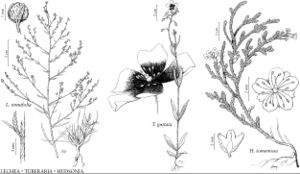Tuberaria
Ann. Sci. Nat., Bot., sér. 2, 6: 364. 1836.
| Taxon | Illustrator ⠉ | |
|---|---|---|
 | Lechea tenuifolia Tuberaria guttata Hudsonia tomentosa | Linny Heagy Linny Heagy Linny Heagy |
Herbs annual [perennial], 0.3–2 (–3) [–8] dm. Leaves mostly opposite, basal soon withering, sometimes in rosettes, distal cauline sometimes alternate, stipulate or estipulate, petiolate or sessile; blade usually 3 [–5] -veined from base, margins sometimes revolute, surfaces hairy [glabrous], hairs sometimes clustered (stellate). Inflorescences racemiform [helicoid, scorpioid] cymes. Pedicels present; bracts [present or] absent. Flowers chasmogamous and cleistogamous, nodding or pendulous in bud. Chasmogamous flowers: sepals persistent, 5, outer smaller than [equaling] inner; petals 5, yellow, sometimes purple to brown at or near bases; stamens 10–15+; filaments distinct, outer stamens often sterile; carpels 3; styles 0; stigmas 1, ± sessile, hemispheric [obconic]. Cleistogamous flowers similar; petals 0; stamens 5–12. Capsules 3-valved. Seeds 6–50+ per capsule. x = 9.
Distribution
Introduced; Calif., c, w Europe, n Africa
Discussion
Tuberaria differs from Crocanthemum and Helianthemum primarily in habit, mostly opposite leaves, and sessile or subsessile stigmas.
Species 8–12 (1 in the flora).
Selected References
None.
Lower Taxa
"dm" is not declared as a valid unit of measurement for this property.